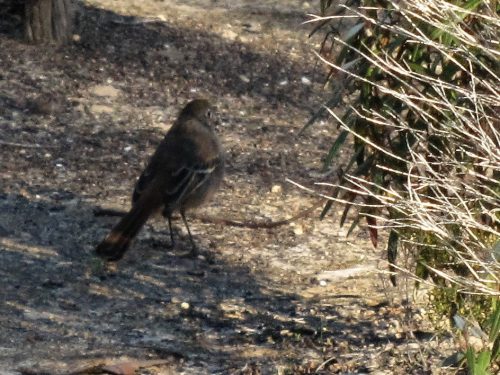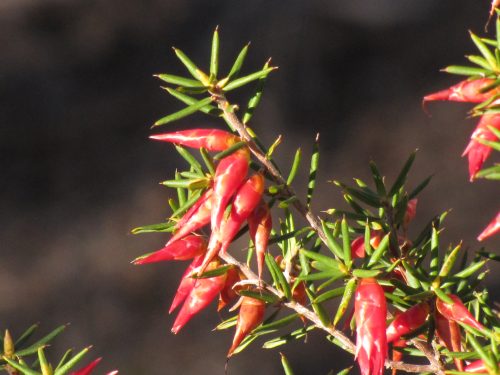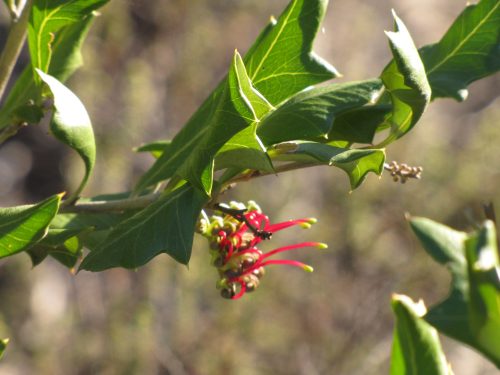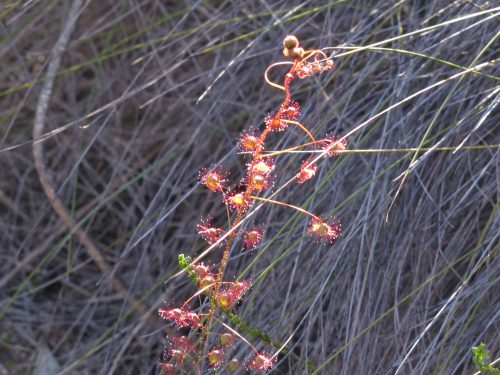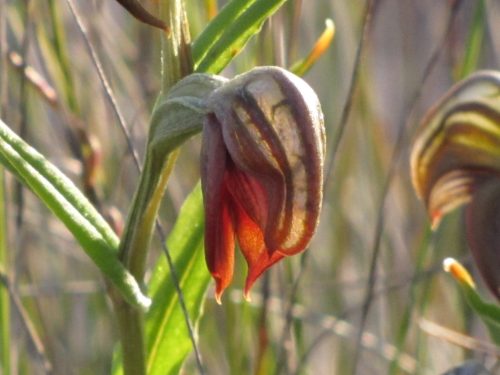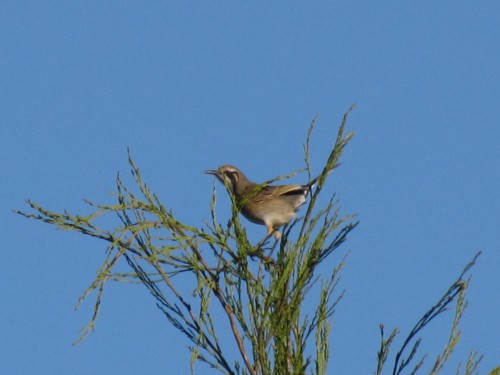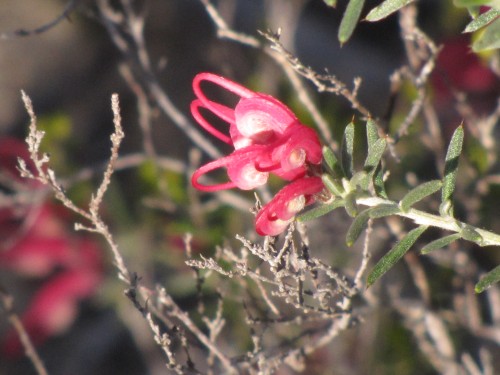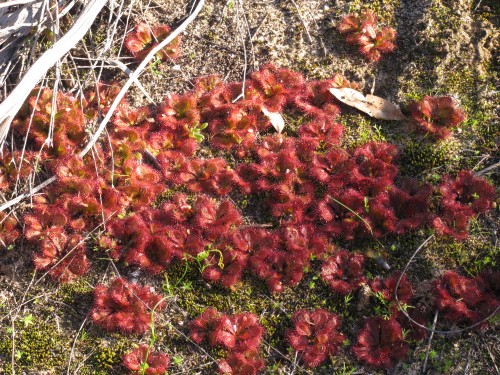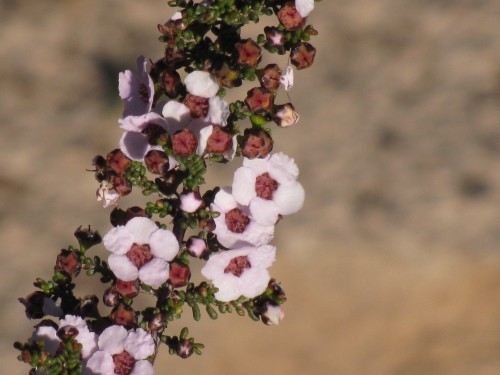A visit to Monarto Conservation Park
A few months ago my wife and I paid a visit to the Monarto Conservation Park in South Australia. This park is south-east of Adelaide and south-west of Murray Bridge where we live. It is about a twenty-minute drive from home. The park is mainly mallee scrub but it contains a good range of small and medium-size native wildflowers, some of which I have shown in the photos below.
On the day we visited, I did not see or hear all that many birds. This is not unusual; some days are like that and very few are seen, while other days you don’t know where to look first – there are so many birds to watch. On this occasion, the only bird I managed a reasonable photo of is the Southern Scrub-robin shown in the photo above. I have found this species to be a somewhat shy bird that skulks in the undergrowth. I followed this individual for about five minutes before it disappeared from view. I could hear it – and others – calling from time to time, but none of them came out in the open to enable a better shot.
This park boasts a wide range of native Australian wildflowers. There always seems to be something flowering, so honeyeaters are common in the park. One can also expect to see, or hear, both types of Pardalote, several species of pigeons, parrots and lorikeets, as well as the elusive Shy Heathwren. Fairy-wrens are also common in the park, as are several species of birds of prey, usually seen soaring overhead. You can also see Australian Magpies, Grey Currawongs, Little Ravens, Grey Butcherbirds and several kinds of swallows.
Access to the park is via Ferries-McDonald Road, a sealed road off the South-eastern Freeway. There is a carpark on the right as you travel south. There are no facilities in or roads through the park, but there is a well-defined walking track starting at the carpark. This is an easy 45-minute walk through a variety of habitats in the north-eastern corner of the park. All of the photos featured today were taken along this walking track in early July of 2017.
Tawny-crowned Honeyeater at Monarto CP
A few days ago my wife and I took advantage of a lovely sunny winter’s day. We’ve had some very gloomy overcast weather in the last month or so, and some sunshine was an event to celebrate. We went for a drive to Monarto Conservation Park which is about a 15 minute drive from our home in Murray Bridge. Monarto CP is about 60km south east of Adelaide in South Australia.
Mind you, the sun may have been shining, and there were no clouds in the sky, and we were well rugged up, but the breeze was still chilly. Never mind, we packed the folding chairs, a Thermos of hot water, some tea bags and some biscuits for afternoon tea. We were prepared.
Before indulging in our treats we went on the walking trail through the park. This is an easy, almost level sandy track through several different habitats. Despite the recent poor weather we were delighted to see so many native plants in flower. I have included a few photos below. While my wife has a good working knowledge of our native birds, her main interest is in the native plants (you can read about her interest on her site here).
I have found over the years that birding in the Monarto Conservation Park can be rather hit or miss. Sometimes the birds can be singing and busily feeding and flying around. On other occasions the bird life can be quiet and inactive. Much of this is due to two main factors: weather conditions and what is flowering.
On this occasion there seemed to be a great deal of activity but, wouldn’t you know it – the birds were not showing themselves all that much. In fact, I only managed reasonable – certainly not brilliant – photos of one species: the Tawny-crowned Honeyeater as shown in the photo above. I should be pleased; the photos taken were the first I have managed of this species.
This honeyeater is a widespread species of southern Australia, from coastal NSW and Tasmania, much of Victoria, southern South Australia and south-western Western Australia. Its preferred habitats include mallee, heathlands, eucalyptus woodlands and street trees. It can easily be confused with the similar looking Crescent Honeyeater – which initially I did.
Further reading:
- Crescent Honeyeater
- An afternoon walk in Monarto Conservation Park
- Birds of Monarto Conservation Park
Bird list:
- Spiny-cheeked Honeyeater
- Red Wattlebird
- Mallee Ringneck parrot
- Silvereye
- Grey Shrike-thrush
- Australian Magpie
- Southern Scrub-robin
- Grey Currawong
- Weebill
- Grey Fantail
- New Holland Honeyeater
- Brown-headed Honeyeater
- Grey Butcherbird
- Tawny-crowned Honeyeater
- Little Raven
- Willie Watail
- Black-faced Cuckoo-shrike
- Shy heathwren
Mallee Fowl in the Murraylands region
Nearly 9 years ago I wrote the following article:
A few days ago I had a new comment on this post with an observation about the lack of Mallee Fowl in the park. Here is the comment:
I visited Ferries MacDonald CP on Tuesday 23 June and noticed that 1080 poison baits have been used to attempt to eradicate foxes. There were signs on the boundary fences warning dog owners. I did not see any mallee fowl despite spending several hours wandering through and around the park. I suspect there are none left unfortunately. I last visited the park thirty years ago and saw one there at that time as well as a few active nests. The park is not large and is surrounded by farmland. It may be too small to provide a suitable habitat for mallee fowl. I hope I am wrong. David.
The following was my reply:
As a result of your comments my wife and I briefly visited the park last Sunday. We actually spent more time in the nearby Monarto Conservation Park.
The poison baits programme has been ongoing for quite some time, probably years, and is a common practice in many parts of Australia. I have walked through both of these parks on numerous occasions over the last 30 years (I live in Murray Bridge) and have only ever seen Mallee Fowl on one occasion, two together on the side of the road near where the two roads intersect.
Last Sunday I checked on one of the Mallee fowl nest mounds that I have checked regularly since finding it some 10 years ago. It was active as recently as about 3 years ago, but sadly it now looks as if it hasn’t been used in at least the last two years, possibly longer. I know of at least 3 other mounds but I would be hard pressed to find them now. Extensive surveys of nesting sites have been conducted but I do not know when the last was done, nor the results.
On a related matter, national parks rangers were, I believe, removing eggs from the active nests, taking them to Monarto Zoo for hatching artificially and then returning the birds to the wild, including this park. Some birds were released with radio tracking devices and the failure rate was near to 100%, probably due to fox predation.
On a brighter note, a friend who lives less than a kilometre from the park saw a Mallee Fowl wandering through his garden only last year, so there is hope that some are surviving in this area. There are also regular reports of sightings east of the Murray River, and from the south east parts of the state.
Further reading:
- Ferries-McDonald Conservation Park – now updated with new information
- Mallee Fowl – the incubator bird
- What kind of duck was that? An exciting observation of Mallee Fowls
- Birds of Monarto Conservation Park
An afternoon walk in Monarto Conservation Park
A few Saturdays ago I took my elderly mother-in-law on a short drive to Monarto Conservation Park. This park is about 20 minutes by car from our home in Murray Bridge, South Australia. The open range Monarto Zoo is just north of the park. This area is one of our favourite places to see native Australian plants.
The park preserves a large parcel of remnant mallee scrub between the lower reaches of the Murray River to the east, and the Mt Lofty Ranges to the west. The park has several mallee forms of eucalypt (eg Eucalyptus dumosa), native pines (Callitris preissii) and a variety of understory plants like correas, native orchids and a many others.
There is one established walking trail through the north eastern corner of the park starting and ending at the car park. This easy 45 minute walk takes the visitor through a range of plant habitats giving a good overview of the vegetation native to this area. When in flower in winter and spring this is a delightful walk with much to interest keen botanists.
In my experience of many visits to this park over the last three decades the birding can be fickle, largely dependent on what is flowering. Many of our honeyeater species, for example, are highly nomadic, moving quickly to areas of abundant food sources. On this recent visit the birding was rather poor.
The following list is a poor representation of the bird life present in this area:
- Black-faced Cuckoo-shrike: 5 seen, an unusually high number together
- Grey Currawong: several heard and one seen
- New Holland Honeyeater: often present in large numbers, perhaps only 4 or 5 seen this time.
- Red Wattlebird: one seen and several more heard calling
- Little Raven: heard calling from adjacent farmland
- Welcome Swallow: several seen swooping low over the treetops
- Adelaide Rosella: two disturbed from a tree as we walked along the path
- Australian Magpie: many seen in nearby farmland
- Weebill: a small flock heard nearby
As we were driving home via a different route we had fabulous views of two Wedge-tailed Eagles gliding low over the scrub in front of us. Nice end to a slow birding day.
This article was updated in July 2015.
